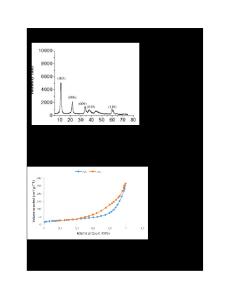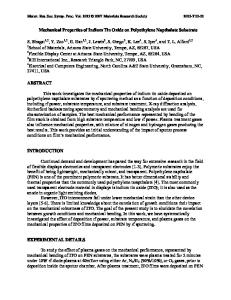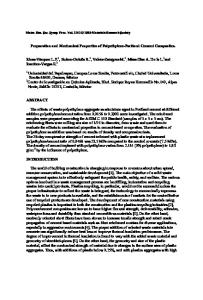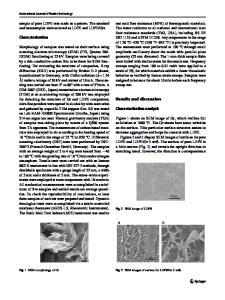Structural, Rheological, and Mechanical Properties of Binary Compounds Based on High-Density Polyethylene and Linear Low
- PDF / 296,170 Bytes
- 9 Pages / 612 x 792 pts (letter) Page_size
- 91 Downloads / 315 Views
OMOLECULAR COMPOUNDS AND POLYMERIC MATERIALS
Structural, Rheological, and Mechanical Properties of Binary Compounds Based on High-Density Polyethylene and Linear Low-Density Polyethylene N. M. Shaidullina,*, I. I. Salakhova, V. N. Borisenkoa, A. N. Tavtorkinb, and I. E. Nifant’evb b
a PJSC Nizhnekamskneftekhim, Nizhnekamsk, Tatarstan, 423574 Russia Topchiev Institute of Petrochemical Synthesis, Russian Academy of Sciences, Moscow, 119991 Russia *e-mail: [email protected]
Received December 9, 2019; revised March 2, 2020; accepted May 26, 2020
Abstract—Rheological, molecular, thermal, and mechanical properties of binary blends based on bimodal highdensity polyethylene (HDPE; ethylene–1-hexene copolymer) and unimodal linear low-density polyethylene (LLDPE; ethylene–1-butene–1-hexene terpolymer) were studied. Six blends with different HDPE/LLDPE weight ratios, 80/20, 70/30, 60/40, 50/50, 40/60, and 20/80, were prepared by blending in a double-worm extruder. The correlation of the rheological properties of the blends, analyzed by the capillary and rotation methods, with the melt flow index and molecular characteristics was demonstrated. LLDPE with increased flowability (MFI = 3 g/10 min) as a polymer additive is an effective plasticizer allowing control of the melt viscosity in a wide range and choice of the optimum target value of the melt flow index of the blend. The activation energy of the melt flow was calculated, and the relationship between this quantity and the content of short-chain branchings in polyethylene blends was revealed. The blends obtained are homogeneous, but an increase in the content of LLDPE in HDPE leads to a change in the polyethylene structure, which is confirmed by a decrease in the crystallinity and in the lamella thickness. The strength values at the yield point and at break decrease with an increase in the fraction of LLDPE in HDPE. Changes in the properties of these blends in their processing into a film by flat-die extrusion were studied. Keywords: high-density polyethylene, linear low-density polyethylene, blend, rheology, molecular characteristics, thermal properties DOI: 10.1134/S1070427220080108
Introduction of chemically similar but more readily processable modifiers is an efficient way to facilitate processing of high-viscosity polymer systems. Such modifying additives influence the melt flow and ensure the required viscosity of the molten blend. Unimodal linear low-density polyethylene (LLDPE), which is a copolymer with an α-olefin (with 1-butene, 1-hexene, or 1-octene), is sometimes used as a modifier. Ethylene copolymers with 1-butene or 1-hexene are used most widely; however, published data on using as a modifier LLDPE containing both α-olefin comonomers are scarce. Appearance of terpolymers with increased melt flow index (MFI) on the market and use of such products as modifying additives to high-viscosity polyethylenes with low MFI can expand the range of commercial products.
Polyethylene-based thermoplastic blends attract scientific and commercial interest for decades [1–3]. Blends of low-
Data Loading...










